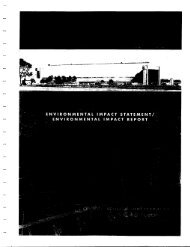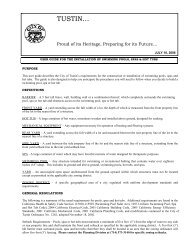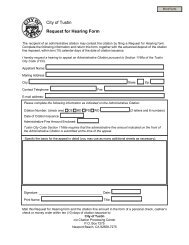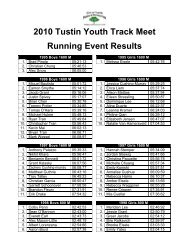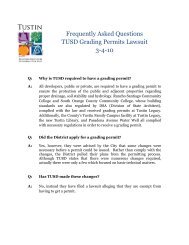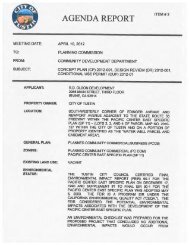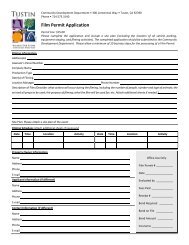Report - City of Tustin
Report - City of Tustin
Report - City of Tustin
You also want an ePaper? Increase the reach of your titles
YUMPU automatically turns print PDFs into web optimized ePapers that Google loves.
S1201b WHO Electromagnetic fields and publ<br />
A number <strong>of</strong> studies have investigated the effects <strong>of</strong> radi<strong>of</strong>requency fields on brain electrical activity cognitive function<br />
sleep heart rate and blood pressw<br />
in volunteers To date research does not suggest any consistent evidence <strong>of</strong><br />
adverse health effects from exposure to radi<strong>of</strong>requency fields at levels below those that cause tissue heating Further<br />
research has not been able to provide support for a causal relationship between exposure to electromagnetic fields and<br />
self reported symptoms orelectroma metic hypersensitivity<br />
In contrast research has cleaa ly shown an increased risk <strong>of</strong> roaduatfic injuries when drivers use mobile phones either<br />
handheld or hands Free while driving nseveral countries mota ists are prohibited or strongly discouraged from<br />
using mobile phones while driving<br />
Long term effects<br />
Epidemiological research examining potential long term risks From radi<strong>of</strong>requency exposure has mostly looked for an<br />
association between brain tumours and mobile phone use However because many cancers are not detectable until<br />
many years after the interactions that led to the tumour and sines mobile phones were not widely used until the early<br />
1990x epidemiological studies at present can only assess those cancers that become evident within shorter time periods<br />
Iowever results <strong>of</strong> anima studies consistently show no increased cancer risk for long term exposure to radi<strong>of</strong>requency<br />
fields<br />
Sevel al large multinational epidemiological studies have been completed or are ongoing including ease control studies<br />
and prospective cohort studies examining a number <strong>of</strong>health endpoints in adults To date results <strong>of</strong> epidemiological<br />
studies provide no consistent evidence <strong>of</strong>a causal relationship between radi<strong>of</strong>requency exposure and any adverse health<br />
effect Yet these studies have too many limitations to completely rule out an association<br />
A retrospective case control study on adults INTERPHONE coordinated by the nternational Agency for Research on<br />
Cancer IARC was designed to determine whether there are links between use <strong>of</strong> mobile phones and head and neck<br />
cancers in adults The international pooled analysis <strong>of</strong> data gathered from I3 participating countries found no increased<br />
risk <strong>of</strong>i gtioma or meningioma with mobile phone use <strong>of</strong> more than 1 U years There are some indications <strong>of</strong> an increased<br />
risk<strong>of</strong>i gtioma or those who reported the highest 10<strong>of</strong> cumulative hours <strong>of</strong>cell phone use although there was no<br />
consistent trend <strong>of</strong>increasing risk with greater duration <strong>of</strong> use Researchers concluded that biases acid errors limit the<br />
strength <strong>of</strong> theseconclusions and prevent a causal interpretation<br />
While an increased risk oibrain tumorti is not established from INTERPHONIr data the increasing use <strong>of</strong>mobile phones<br />
and the lack <strong>of</strong> data for mobile phone use over time periods longer than IS years warrant further research <strong>of</strong> mobile<br />
phone use and brain cancer risk In particular with the recent popularity <strong>of</strong> mobile phone use among younger people<br />
and therei orea potentially longer lifetime <strong>of</strong> exposure WHO has promoted further research on this group Several<br />
studies investigating potential health effects in children and adolescents are underway<br />
Exposure limit guidelines<br />
Radi<strong>of</strong>requency exposure limits For mobile phone users are given in terms <strong>of</strong> Specific Absorption Rate SAR the rate<br />
<strong>of</strong> radi<strong>of</strong>requency energy absorption pear unit mass <strong>of</strong> the body Currently two international bodies<br />
have developed<br />
exposure guidelines for workers and for the general public except patients undergoing medical diagnosis or treatment<br />
These guidelines are based on a detailed assessment <strong>of</strong> the available scientific evidence<br />
WHO S response<br />
in response to public and governmental concern WI IO established the International Electromagrnc tic Fields EMF<br />
Pro jest in 1996 to assess thescientife evidence <strong>of</strong> possible adverse health effects fi om electromagnetic fields WHO<br />
will conduct a formal health risk assessment <strong>of</strong> radi<strong>of</strong>requency fields exposure by 2012 Mea iwhile the International<br />
Agency for Research on Cancer ARC a WHO specialized agency is expected to review the carcinogenic potc tial <strong>of</strong><br />
mobile phones in 2011<br />
WHO also identities and promotes research priorities for radi<strong>of</strong>requency fields and health to till gaps in knowledge<br />
through its Research Agendas<br />
WHO develops public information materials and promotes dialogue among scientists governments industry and the<br />
public to raise the level <strong>of</strong> understanding about potential adverse health risks <strong>of</strong>mobile phones<br />
who<br />
mediacentre print html 23



